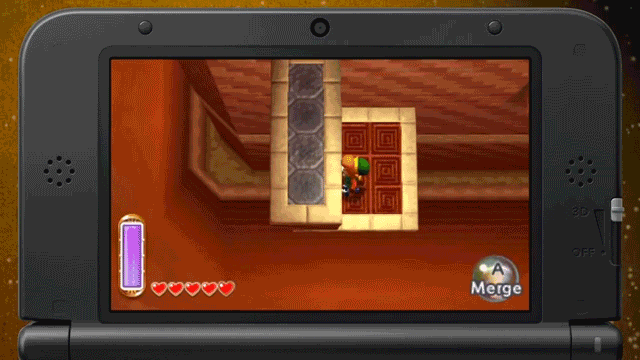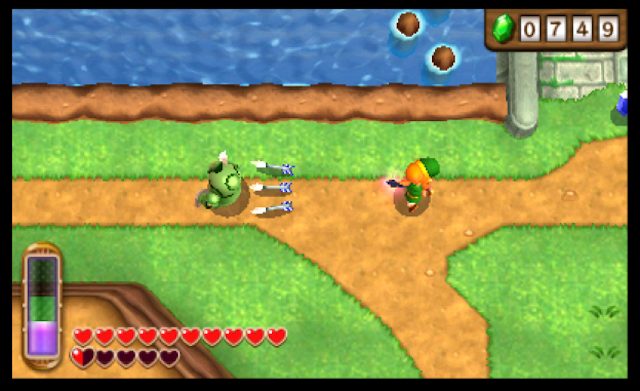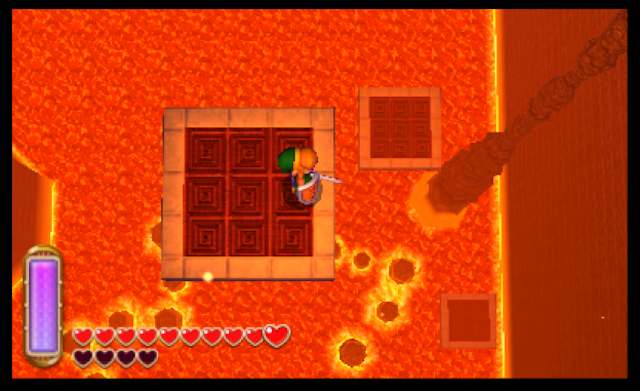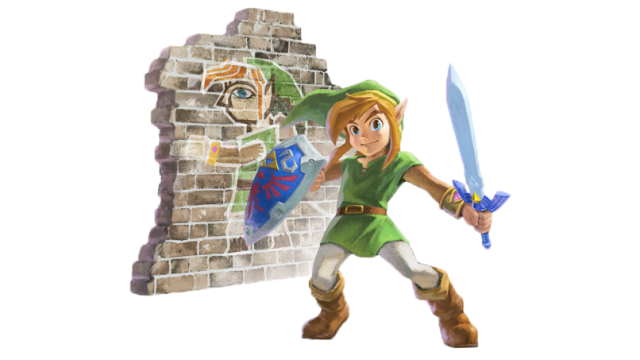I’ve done a lot of things in Zelda games — sailing, time travel, saving Hyrule… you name it. Much of it — the bulk of what you do in Zelda games — could be considered old hat, depending on who you ask. That’s kind of always the vague fear when there’s a new Zelda game, isn’t it? That it’ll be more of the same?
This Tuesday, I got a chance to sit down with the new, upcoming 3DS Zelda game, A Link Between Worlds. Some of it, to be sure, felt like classic Zelda: dungeons, lots of puzzles, that sort of thing. But some of it also felt, well, new. Novel, even.
Let’s start at the beginning. A Link Between Worlds takes place hundreds of years after A Link To The Past — the citizens you come across may not be the same, but it still involves the same Hyrule. However, in this Zelda, the bulk of your worries won’t be Hyrule — Hyrule seems to be enjoying a time of peace. No, instead Link has to save the descendants of the Seven Sages who are located in Lorule, a place Link can visit by traversing through cracks found in Hyrule. You do this by, um…merging into the wall and moving about as if you were a painting.

How does Link do it, why does Link have this power? I have no idea, but the mechanic does make sense. Look at it. It’s the type of ‘cave painting come to life’ deal you see in stuff where someone retells an ancient legend or myth — which I think The Hero of Time definitely qualifies as, at this point. It’s also worth noting that you’re not the only one with this ability…the big bad in this game has kidnapped the Seven Sages by turning them into paintings. Maybe we’ll learn more about this ability as we go farther into the game.
In any case, every crack in Hyrule corresponds with a specific place on the map in Lorule. Lorule itself has seven dungeons, and though these dungeons may seem similar to those in A Link To The Past, they’ve got different sorts of puzzles and layout. All seven of these dungeons are available for you to explore in whatever order you see fit — a first in the franchise. The question is, do you have the right tools for the job? Each dungeon may ask something different of you, and you may or may not have the appropriate weapon or tool at your disposal to go forward. That’s where the shop comes in. In another franchise first, players will be able to rent or buy all the classic Zelda weapons we know and love, from boomerangs to bows and everything in between.
My demo took place somewhere midway through the game — I had 1.4k rupees in my pocket. Naturally, I visited the shop to see what I could do with this money. I noticed that permanently purchasing a boomerang would cost 400 rupees, and renting it would be significantly cheaper — it was the same sort of deal with the other items too, though you should have enough cash to purchase all the items in the shop by the end of the game. You’ll also be able to upgrade these items, provided you collect the right creature as you go along.
The thing about renting is, should you die halfway through a dungeon, that’s it. The items you rented are gone; you’ll need to rent them again. Things could potentially get pricey (not that this stopped me from renting every single thing in the shop in my first go — just in case!). The good news is that your progress in the dungeon — say, any puzzles you’ve solved or doors you’ve opened — stays intact. That, and you’ll have a choice of continuing your game from the dungeon or from Link’s home.
On the one hand, this set-up sounds exciting — being able to rent and then lose all your items after death reminds me a little of how roguelikes handle items. High stakes sort of deal. On the other hand, many fear that this system would easily allow Nintendo to introduce microtransactions into Zelda. Here’s the good news: when asked about this, a Nintendo representative laughed and told Kotaku that microtransactions are not happening in Zelda. No cash. Besides, what kind of rupee-to-cash conversion could we expect have when you can just find rupees in the grass in the game?
So, that’s one thing you don’t have to worry about. Let’s talk about the dungeons a bit. Because the game aims to take advantage of the 3DS’ 3D capabilities, much of the game is vertical — the view itself is top-down, and much of the game is spent going either higher or lower into a dungeon. This, combined with the merging ability, forced me to think of space differently than I would not just Zelda game, but most games in general. A small area feels like it can have much more complexity than before — you can traverse the area normally, or explore it by merging to the wall (adding more surface area to cover), and then, on top of that, you might spend a lot of time going higher or lower in just one specific corner of the dungeon map.
The concept of merging itself changes how you think about things. You’ll look at these particular puzzles differently. The biggest obstacle, which would normally be a barred-up room or something, is more in how you think about its solution and less the solution itself. You have to wrap your head around this specific ability and almost act like the obstacle isn’t there to begin with — because in this example, you’d simply be able to go through the bars.

So there’s a new type of puzzle, sure, but how difficult is the game? You might be interested in knowing that this Zelda doesn’t necessarily have dungeons that scale in difficulty, but rather that each dungeon features a different variety of puzzle types. This Zelda will have a more difficult Hero mode available, but I wasn’t told how this mode would work.
It’s not all puzzles of course, sometimes the merge ability is about timing — there was a part in the dungeon I explored where I had to go on a conveyor belt which would normally toss me into a bottomless pit unless I merged to the wall at the right moment. And sometimes, you might come across a painting of an item only to find you can pop it back out with you, should you unmerge in the right location. Though I didn’t get to see too much of the game, it’s clear that A Link Between Worlds uses this new mechanic in a lot of nifty ways.

It’s also worth noting that there’s some leeway with the ‘having the right items with you in the appropriate dungeon’ requirement. I came across some puzzles that required bombs, which you can purchase, sure — but the dungeon itself, in this specific case, gave me access to an enemy that I could use as a bomb too. So I’d still be able to go forward even if I didn’t come equipped with everything I need — and it’s possible other dungeons may allow you to do the same thing with different items.
One curious thing about the way items work in this game is that I felt myself somewhat less excited about the dungeons — I knew that regardless of how deep I explored any given dungeon, I wasn’t about to find some awesome new item to add to my arsenal. It’s funny though, because the whole ‘go to a dungeon, find a new item, use item in all the puzzles in that dungeon set-up is something I’ve experienced many times before. You’d think that I’d grow tired of it. Apparently not. There’s just something less cool about, say, a Hookshot when you can just have a Hookshot from the get-go, you know?
I was less excited maybe, but not less engaged — the constant puzzles and the neat new mechanic kept me happily going forward even though, admittedly, I’m one of those folk who feels that many Zelda games can feel kind of samey. Good thing, too. I was beginning to miss Link a little.

Comments
17 responses to “How The New Zelda Game Is Different (Hint: It’s Not Microtransactions)”
That isn’t the right shield for this timeline.
And what information are you basing that off of?
‘Lorule’???
Seriously?
It sounds like they asked a room full of particularly dimwitted 10 year olds to come up with a name for an alternative dimension Hyrule and took the first smartass answer they were given.
That’s got to be the least creative name I’ve ever heard for an imaginary location. It makes Dragon Age II’s ‘Darktown’ slums (hilariously mocked in Far Cry 3) sound absolutely visionary.
I’m sure this game will still be good, although I had trouble getting into the two 3DS Zelda games.
I’d say it’s less about smartarsery and more about the two places being intertwined. Since the game is actually called “A Link Between Worlds” and is a follow-up to Link to the Past, which had the whole light world/dark world mechanic, the Lorule name as a counter to Hyrule would be very deliberate.
It may be deliberate, but man it’s dumb.
It’s far more creative than “dark world”.
Only just.
“Hey, what are we going to call the alternative Hyrule?”
“Well, ‘Hy’ kinda sounds like High. Low is the opposite of High. How about ‘Lorule’?”
“Nobody would ever name a place Lorule, its completely ridiculous and makes the place sound intentionally shit.”
“Yeah but opposites are cleaver. Let’s go to the pub”.
Yeah, it would’ve taken them all of 1 – 2 minutes to come up with that, absolutely zero effort.
who cares, it’s a name. i’m more concerned with how it will play, and from all reports it will play amazingly.
As an Australian, home of the literal place name, I have no issue with Lo being the opposite of Hy. Whilst it isn’t particularly “creative”, it makes sense. LTTP’s is the “Dark World”, which is far less clever.
I don’t think it’s worth criticising. I mean seriously, it’s a game with a PUN in it’s title.
I love the way you criticize but don’t come up with any alternative names.
Please do share what you think would be a better name for the alternative dimension.
So psyched!
I do love finding new items part way through the dungeon. Wonder if they’ll do this in the WiiU version.
So… open the game. Spend six hours running into houses and breaking pots (Or slashing grass), buy all the weapons from the get go. Laugh. Cry a little. Laugh some more.
Obviously never played The Legend of Zelda on the NES….
Yeah no, not all Dungeons were accessible from the start in Zelda on the NES, one you needed bombs for which you did not have at the start of the game, another required the raft to access it and another required the whistle to access, both of which were found by going through other dungeons.
Bit excited about them trying something different. In particular the renting sounds great – I love anything that puts genuine stakes on death in games.